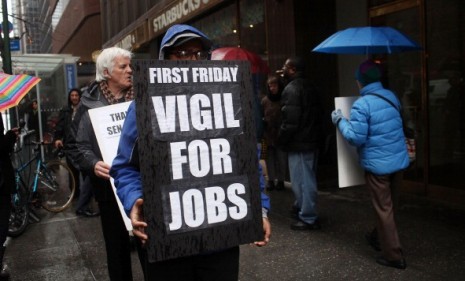Unemployment is down... but here's the bad news
Don't break out the bubbly just yet. Unemployment may have reached a two-year low in March, but here are six reasons why real recovery may still be far, far away

Happy Friday... or is it? According to a new report from the Bureau of Labor Statistics, the U.S. economy added 216,000 jobs in March, and the unemployment rate dropped to 8.8 percent, the lowest it's been in two years. That 8.8 percent figure also marks a full percentage point drop since November 2010, an "astounding decline." But amid all the good news in the new jobs reports, there are some "hidden bad signs," says Phil Izzo in The Wall Street Journal. Here are six:
1. Many have been unemployed for a long, long time
Among the unemployed, 45.5 percent have been jobless for six months or longer, says Jacob Goldstein at NPR. "The longer people have been unemployed, the less likely it is that they will find another job."
The Week
Escape your echo chamber. Get the facts behind the news, plus analysis from multiple perspectives.

Sign up for The Week's Free Newsletters
From our morning news briefing to a weekly Good News Newsletter, get the best of The Week delivered directly to your inbox.
From our morning news briefing to a weekly Good News Newsletter, get the best of The Week delivered directly to your inbox.
2. We still need a lot more new jobs
"Where are the new jobs?" asks Kelly Evans in The Wall Street Journal. While new weekly jobless claims are at a two-and-a-half-year low, "hiring remains weak." Layoffs have declined, but hiring is still short of what's needed to recoup the 8.7 million jobs lost in the recession. "Call it the no-fire, no-hire job market."
3. The unemployment rate has dropped too quickly
Since October 2010, the unemployment rate has plummeted from 10.1 percent to 8.8 percent — and that has economists worried, says Stephen Gandel in TIME. Such rapid job growth could cause inflation. Or, because of the way the unemployment rate is calculated (it only includes those actively looking for work), the drop could indicate that people have simply given up looking for work, not that they've actually found jobs.
A free daily email with the biggest news stories of the day – and the best features from TheWeek.com
4. And it's not down everywhere
"The recovery is leaving some U.S. metros behind," says Aaron Couch in The Christian Science Monitor. Some smallers cities, like Bend, Ore. (unemployment rate: 15.2 percent) and Palm Coast, Fla. (16 percent), actually have higher rates of unemployment now than they did in June 2009, when the recovery officially began.
5. Wages aren't rising, but the cost of living is
The cost of food and oil is on the rise, but wages remain unchanged, says Phil Izzo in The Wall Street Journal. "If prices are going up but workers aren't getting paid more, it spells good news for companies who can keep labor costs low, but suggests continued struggles for consumers."
6. The slightly better times may not last
"The jobs report is a lagging indicator, and some of the issues that have led economists to scale back growth forecasts for this year aren't yet reflected in this report," says Izzo. The Japanese earthquake will likely cause some disruptions in manufacturing supply chains, the effects of which could be felt for months. "There might be some difficulties ahead."


